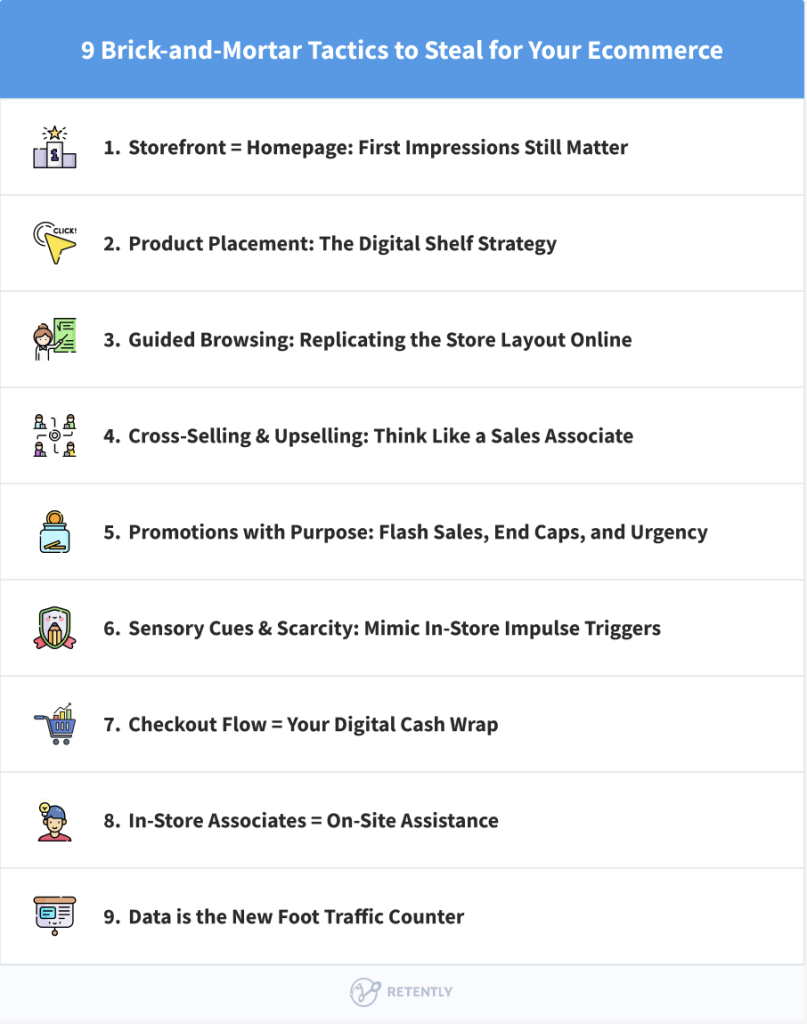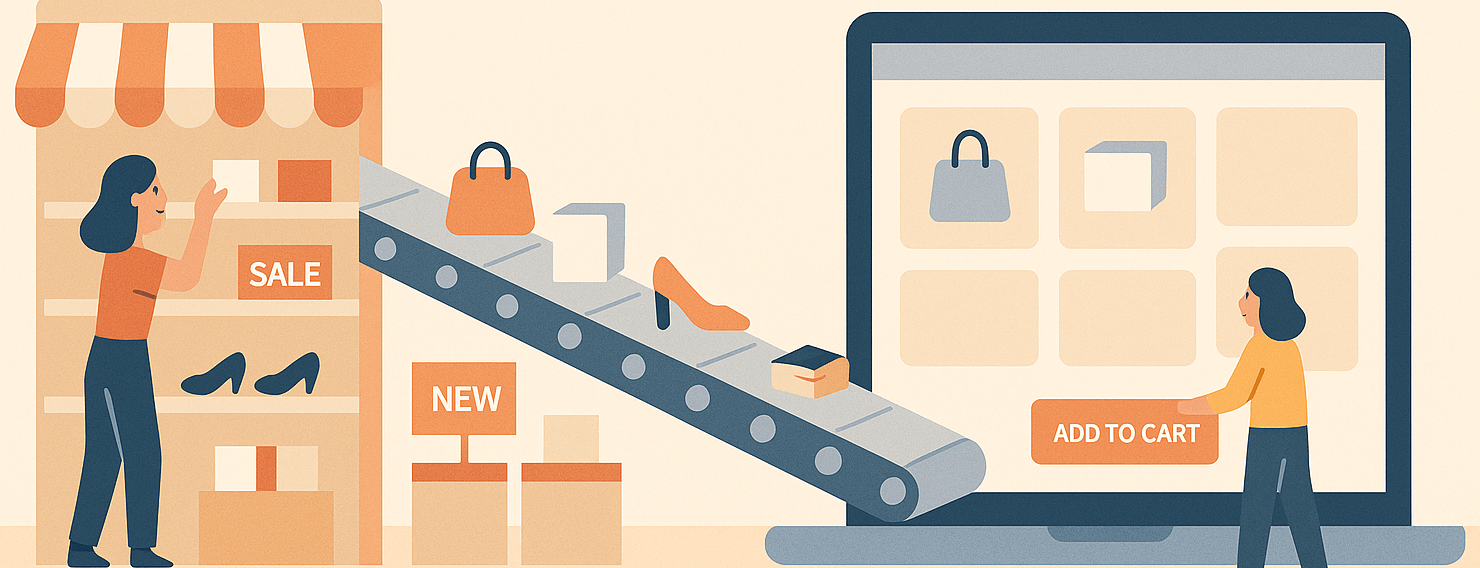Table of Contents
- Key Takeaways
- 1. Storefront = Homepage: First Impressions Still Matter
- 2. Product Placement: The Digital Shelf Strategy
- 3. Guided Browsing: Replicating the Store Layout Online
- 4. Cross-Selling & Upselling: Think Like a Sales Associate
- 5. Promotions with Purpose: Flash Sales, End Caps, and Urgency
- 6. Sensory Cues & Scarcity: Mimic In-Store Impulse Triggers
- 7. Checkout Flow = Your Digital Cash Wrap
- 8. In-Store Associates = On-Site Assistance
- 9. Data is the New Foot Traffic Counter
- Conclusion: Merchandising Is Psychology, Not Just Design
Ever wonder why supermarkets always stash the milk in the back… or why candy magically appears right when you’re about to check out? It’s not random. It’s all part of a clever game called merchandising strategy, and it works.
These in-store tricks are designed to guide your journey, tempt your taste buds, and yes, get a few extra dollars into the cart. The best part is that those same principles can work wonders in your online store, too.
Think of it this way – your homepage is the window display, your product pages are the shelves, and your checkout is your digital cash register. Once you see your online store through that retail lens, everything starts to click.
In this guide, we’ll walk through tried-and-true tactics from brick-and-mortar retail and show you exactly how to apply them to your ecommerce merchandising strategy. You’ll get simple, real-world ideas to make your products more discoverable, increase order value, and turn browsers into buyers. No fluff. Just smart moves inspired by stores you already know.
Let’s dive in.
Key Takeaways
- Borrow proven in-store tactics, like eye-level product placement or impulse buy, and adapt them to your online layout, from homepage to checkout.
- Just like store aisles and displays guide browsing, your store UX (navigation, filters, recommendations) should lead customers to discover, not just search.
- Use urgency, scarcity, and social proof strategically to trigger action, but always authentically to build trust, not pressure.
- Treat scroll depth, click maps, and product interactions as your digital “footfall.” These insights are gold for optimizing layout and strategy.
- From smart upsells to helpful chat prompts, use every touchpoint to enhance the customer experience and gently grow your average order value.
1. Storefront = Homepage: First Impressions Still Matter
Walk past a great retail store, and what grabs your attention? Maybe it’s a bold window display, cozy lighting, or a sign shouting “New Arrivals!” That’s no accident. Retailers know they’ve got just a few seconds to pull you in, and your ecommerce homepage works the exact same way.
Think of your homepage as your digital storefront. It’s the first thing shoppers see, and it sets the tone for everything else. A cluttered, outdated, or confusing homepage? That’s like walking into a dimly lit store with dusty mannequins – not exactly inviting.
Instead, use hero banners to highlight current promotions or featured collections. Curate your homepage to showcase what’s new, trending, or seasonally relevant. Keep your top CTAs front and center. Don’t make visitors scroll a mile to find the good stuff.
Tip: Just like a physical store changes its display with the seasons, sales, or new arrivals, your ecommerce homepage should stay fresh. Swap out featured products, update visuals, and keep things moving. A homepage that never changes feels like a store stuck in last season’s stock.
Bottom line? Treat your homepage like prime retail real estate. Make it visually sharp, easy to navigate, and packed with reasons to stick around.
2. Product Placement: The Digital Shelf Strategy
In a physical store, there’s a reason the bestsellers are right at eye level and why the flashy promo items sit on those endcap displays by the aisle. It’s all about visibility. If you see it, you’re more likely to buy it. That’s merchandising 101.
Online, the same rules apply, but your “shelves” are digital.
When a shopper lands on a category page or search results, what they see first matters. If your best products are buried on page three, it’s like hiding your most popular items on the bottom shelf in the back of the store. No thanks.
So how do you bring that retail strategy into your ecommerce merchandising strategy? Use smart product placement:
- Put your top-rated or high-converting products at the top of category grids.
- Highlight bundles or promos where they’re most likely to catch attention.
- Don’t leave it all to chance. Use algorithmic sorting to prioritize what’s most relevant to each shopper.
And here’s where the real magic happens: personalization. Tools like personalization engines or merchandising rules (think: Shopify apps, Adobe Commerce, or AI-driven platforms like Nosto or Dynamic Yield) can automatically sort, surface, and spotlight products based on user behavior, location, or season.
Tip: Set rules like “Always show X product in the first 3 slots if it’s on sale” or “Push high-margin items to the top when inventory is low.” It’s like having a smart shelf-stocking assistant that works 24/7.
In short, online shoppers might not be walking past your shelves, but their eyes are scrolling. Make sure what they see first is what you actually want them to buy.
3. Guided Browsing: Replicating the Store Layout Online
Ever walked into an IKEA just to grab one thing and left with a cart full of stuff you didn’t know you needed? That’s not luck. It’s a layout strategy. The store is designed to guide you through a curated buyer journey, sparking inspiration (and extra purchases) along the way.
Now think about your ecommerce store. Are you helping visitors discover products, or are you leaving them to fend for themselves?
Online, there’s no physical floor plan, but your navigation, filters, and page layout are your store map. Done right, they guide shoppers through a smooth, enjoyable experience that leads to bigger carts and better conversions.
Start with clear navigation. Think like a shopper: Is it easy to browse by category, collection, or theme? Or is everything buried in dropdowns?
Use smart filters. Help people narrow down by size, price, color, or availability, just like a helpful sales associate would in-store.
Sprinkle in discovery tools. Features like:
- “Customers also viewed” = the digital version of “you might like this too”
- “Shop the look” or “Shop the room” = like recreating a full in-store display
- Breadcrumbs = give shoppers a clear path back (no one likes feeling lost)
Tip: Don’t assume people know what they’re looking for. A great ecommerce merchandising strategy includes guiding the unsure browser, not just serving the decisive buyer.
The goal? Help shoppers explore your store the way they’d meander through a well-laid-out showroom. The easier and more enjoyable the path, the more they’ll add to their cart along the way.
4. Cross-Selling & Upselling: Think Like a Sales Associate
You know that moment in a store when the cashier says, “Would you like some socks to go with those shoes?” It’s not just small talk, it’s a classic sales move, and it works.
In ecommerce, you don’t have a friendly associate to make suggestions in person, but you can build those prompts right into the shopping experience.
Cross-selling is all about offering complementary products. For example, if someone adds a laptop to their cart → show them laptop sleeves, wireless mice, or a USB hub.
Upselling nudges customers toward a better or more expensive version of what they’re already considering. For example: Browsing the 32″ TV? Suggest the 40″ with built-in streaming for a little more.
Here’s how to bring it to life in your ecommerce merchandising strategy:
- Product bundles: “Buy together and save 10%.” Instant value.
- Frequently bought together: Just like Amazon’s famous module. It works.
- Exit-intent popups: Catch hesitant shoppers before they bounce with a relevant offer or suggestion.
Tip: Use AI-powered tools or behavior-based logic to tailor suggestions. Platforms like Rebuy, LimeSpot, or Dynamic Yield can analyze user behavior and recommend products that actually make sense, not just random add-ons.
Think of it this way: every touchpoint is a chance to help the customer and increase their cart size. Done right, it doesn’t feel pushy; it feels helpful. Just like that associate suggesting socks, you’ll be glad you didn’t forget.
5. Promotions with Purpose: Flash Sales, End Caps, and Urgency
Walk into a store and see a big red sign screaming “Limited Time Offer!” or a display table overflowing with 50% off items? You’re drawn in. That’s classic retail merchandising – grab attention, create urgency, move product.
Online? You’ve got the same opportunity… just with pixels instead of posters.
Your ecommerce merchandising strategy should make promotions pop, not blend in. That means:
- Countdown timers on product pages or banners create a sense of urgency. (“Sale ends in 3h 27m!”)
- Sticky promo banners follow the shopper across the site, reminding them of free shipping thresholds or sitewide discounts.
- Dynamic pricing tools let you run real-time flash sales, tiered discounts, or even volume-based deals that update automatically.
But here’s the catch – don’t overdo it.
If everything is always on sale, or there’s a countdown on every page, customers catch on. And worse, they start to mistrust your brand. Scarcity loses its magic if it feels fake.
Tip: Use urgency sparingly and strategically. Tie promotions to real events (seasonal drops, restocks, end-of-season clearances) and be transparent about what’s actually limited.
In short, treat your promotions like a well-placed endcap – visible, compelling, but never desperate. This way, they’ll drive action without driving people away.

6. Sensory Cues & Scarcity: Mimic In-Store Impulse Triggers
In a physical store, your senses are constantly at play – freshly baked cookies near the bakery, upbeat music in the background, and a “Last One Left!” tag on the shelf. These subtle cues tap into emotion and urgency, nudging you to buy now instead of later.
So, how do you create that same effect online without the smell of cinnamon rolls?
By turning your ecommerce merchandising strategy into a digital sensory experience.
Motion catches the eye. A quick GIF showing product use, a subtle animation on a CTA button, or a “just added to cart” pop-up – all help recreate the movement and energy of a real store.
Social proof is your new in-store crowd. Try messages like:
- “Only 2 left in stock!”
- “12 sold in the last hour”
- “Trending now – don’t miss out!”
Scarcity signals work especially well on product pages. Low-stock badges, limited-edition tags, or countdowns until restock push customers to act before it’s too late.
And yes, FOMO is real. When people feel like they might miss out, the perceived value of the product skyrockets.
Tip: Be honest. Scarcity only builds trust and urgency if it’s genuine. Fake low stock alerts or exaggerated claims can backfire fast.
Bottom line? While you can’t pipe in a scent or play music (yet), you can trigger emotion and action with the right mix of movement, messaging, and honest urgency. It’s the digital version of “better grab it before someone else does.”
7. Checkout Flow = Your Digital Cash Wrap
In a retail store, just before you pay, you pass that irresistible display of gum, chargers, lip balm, or last-minute snacks. It’s not a coincidence but a strategic placement designed to squeeze in one final impulse buy. That area is called the cash wrap, and it’s prime revenue real estate.
In ecommerce, your checkout flow plays the same role.
This is where customers are already in buying mode, wallets out, so it’s the perfect place to gently suggest small, relevant add-ons that boost order value without disrupting the purchase. Try:
- Smart product suggestions: Think “Add a $5 screen cleaner?” or “Need extra laces for those sneakers?”
- Loyalty reminders: Nudge customers to sign up or redeem points before they check out.
- Free shipping thresholds: “You’re $12 away from free shipping, add something and save!” These are powerful, especially when paired with low-cost add-ons.
But here’s the golden rule: don’t introduce friction.
If your upsells slow down checkout, confuse the customer, or feel pushy, you risk cart abandonment. Keep suggestions clear, optional, and lightweight.
Tip: Test what works best for your audience: product-specific add-ons, bundle builders, or incentives like “Save 10% if you subscribe.”
The goal? Make that final stretch feel seamless and helpful. Just like a well-stocked cash wrap, your checkout should close the sale and give shoppers one last chance to say, “Yeah, why not?”
8. In-Store Associates = On-Site Assistance
Think about the last time you walked into a store and a friendly associate greeted you with, “Looking for anything in particular?” It’s not just polite, it’s helpful. Great retail staff know how to guide, recommend, and reassure, turning hesitation into a confident purchase.
Your ecommerce store should do the same. Just because there’s no one physically there doesn’t mean shoppers should feel alone.
Consider on-site assistance. This can take a few different forms:
- Live chat: A real human (or a smart bot) ready to answer product questions or fix a checkout hiccup in real time.
- AI-powered assistants: Think of them as your 24/7 associates offering size suggestions, restock alerts, or personalized recommendations.
- Smart FAQ nudges: Show relevant answers right where customers need them, like “What’s your return policy?” on the cart page.
And yes, real-time help makes a difference. A recent Forrester study found that 44% of shoppers consider having real-time help during their purchase to be one of the most important features a website can offer. That’s a big deal.
Tip: Even if you don’t have a full-time support team, consider using chat tools with smart triggers (like “Need help choosing?”) based on browsing behavior or time spent on page.
Bottom line? The best ecommerce merchandising strategy isn’t just about what you show but also how you support. When shoppers feel guided (not left guessing), they’re more likely to hit buy now with confidence.
9. Data is the New Foot Traffic Counter
In physical stores, managers keep a close eye on foot traffic – where people walk, where they linger, and what displays get ignored. They use this to rearrange shelves, highlight popular items, or fix layout issues. It’s like having a heatmap of human behavior.
Good news: you can do the exact same thing online, just with way more precision.
In ecommerce, data is your footfall tracker. Every click, scroll, and hover tells a story about what’s working and what’s not.
Here’s what to look at:
- Scroll depth: Are visitors actually reaching your product recommendations or bouncing after the hero banner?
- Click tracking: What do they think is clickable? Where do they go next?
- Heatmaps: Tools like Hotjar or Crazy Egg show where people focus (and where they don’t).
- Product interaction: Are people watching videos? Zooming in on photos? Reading reviews? This tells you what’s catching attention.
Tip: Use this data to remerchandise. If shoppers keep skipping a collection, maybe the banner’s not clear, or maybe it’s time to rotate in something new.
Think of it like this: in a real store, you’d notice if no one walked down a certain aisle. Online, you have even more visibility and more control to fix it fast.
At the end of the day, your ecommerce merchandising strategy should be data-driven, not guesswork. Because when you know how people move through your store, you can meet them exactly where they are and nudge them where you want them to go.
Conclusion: Merchandising Is Psychology, Not Just Design
At the end of the day, the best ecommerce merchandising strategy isn’t copying what brick-and-mortar stores do, but translating the psychology behind those tactics into your online world.
It’s about guiding attention, creating desire, and making the buying journey feel effortless. From homepage layouts to product placement, checkout nudges to real-time support, it all comes down to understanding how people shop and helping them do it with confidence.
So here’s your next move: audit your store like a great shop manager would. Ask yourself:
- What do shoppers see first?
- What’s drawing them in or pushing them away?
- Are you showcasing your best products… or hiding them on page three?
- Where are the missed opportunities to cross-sell, upsell, or support?
Don’t leave it to chance. Merchandising is where ecommerce stores turn browsers into buyers.


































 Christina Sol
Christina Sol 




 Greg Raileanu
Greg Raileanu 